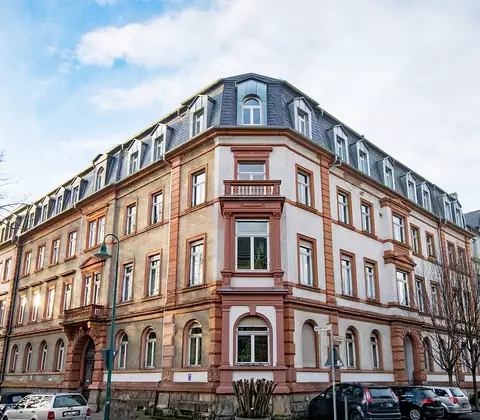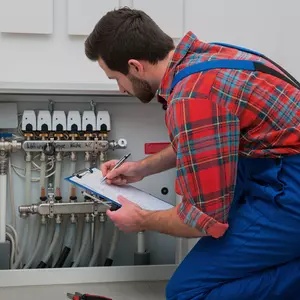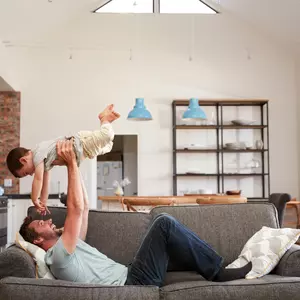
Lowering the cost of heating in old buildings
Around 80% of the energy consumed by private households is accounted for by heating and DHW heating. So there are huge potential savings to be made. To keep costs down and protect the environment, it is vital that any modernisation project must also consider replacement of the existing heating system in old buildings.
But sometimes, even minor changes are enough to save resources when heating old buildings. The following will give you an overview of available systems and measures.
Replace the heating system in an old building? Yes or no?
Was your house built before 1970? If the energy efficiency of your home has not been upgraded since then, it can make sense to replace the heating system in your old building. Old gas and oil heating systems without condensing technology should definitely be replaced with modern equipment.
This is because modern gas heating systems with condensing technology are many times more efficient than older models. But it is not only the heating system that is responsible for power consumption; the building envelope is also a critical factor.
For this reason, the house should be thermally insulated along with replacing the heating system.
If you want to heat your home in the most environmentally friendly way possible, despite living in an old building, gas condensing technology can be coupled with renewable energies. As a home owner looking to install a hybrid heating system of this kind, you usually can choose between a heat pump, such as the CHA-Monoblock, and solar thermal technology, like the solar heating systems made by WOLF.
In hybrid heating systems, renewable energies usually handle the DHW heating and a gas heating system with condensing technology provides the majority of the energy required to heat the old building.
Optimising heating in old buildings
In most cases, it makes sense to replace the heating systems in old buildings. But there are also a few additional measures with which you can save noticeable amounts of energy regardless of the heating system being used. This reduces the burden on your household budget and is good for the environment.
Heating system maintenance
Having your heating system serviced regularly ensures that the heating system in your old building is set correctly and working properly. Only then can it work reliably and efficiently.
Lag heating pipes
Do the pipes of your heating system run through unheated rooms such as the cellar? Then these pipes should be lagged. Hot pipes running through cold rooms lose considerable amounts of heat.
Replace the heating pump
Replacing the heating pump will not save you either oil or gas, but it will save electricity. The pump transports heating water from the heat source to the radiators. Modern pumps are considerably more efficient than old models, a fact that will be clearly reflected in your electricity bill.
Have system hydronically balanced
Hydronic balancing is advisable particularly if you have modernised or changed several parts of your heating system. This involves having a specialist adjust the heating system so that it only produces the heat that is needed. The process also optimises the distribution of heat in old buildings.
This helps to save on heating in old buildings
There are also a few tricks that can help you to reduce your energy consumption when heating old buildings.
Keep the temperatures constant
Radiator thermostats are often turned up or down depending on how warm it is in the specific room. But this continuous change in temperature wastes a great deal of energy. It is better to set a constant temperature.
Different temperatures can be set to suit the various uses of different rooms. For instance, the bedroom can be cooler than the living room. Recommended values for these constant temperatures are as follows:
- Living room: 20°C to 22°C
- Bedroom: 17°C to 18°C
- Kitchen: 18°C to 20°C
- Bathroom: 24°C to 26°C
- Storage rooms, hallways etc.: 17°C to 18°C
Don’t forget ventilation
Airing the interior initially cools the room so the heating system has to work harder. But fresh air warms up better than stale air. This is because the outdoor air is drier so warms up more easily than the moist indoor air.
But it is best not to keep windows cracked open permanently. Instead, air the rooms fully and briefly at regular intervals.
Lower the room temperature
It almost sounds too simple but should not be forgotten as it has great impact: if you reduce the room temperature by 1°C, you lower your heating energy requirements by around 6%. It is important that the temperature does not permanently drop below 17°C anywhere to prevent mould growth.
Furthermore, the doors between rooms kept at different temperatures must be kept closed to prevent heat losses.
Conclusion
There are many ways to save energy when heating old buildings. But in most cases, replacing the heating system is strongly advised, especially in unrenovated buildings.
Find out about the attractive subsidies available, and let WOLF experts advise you on your specific case.


